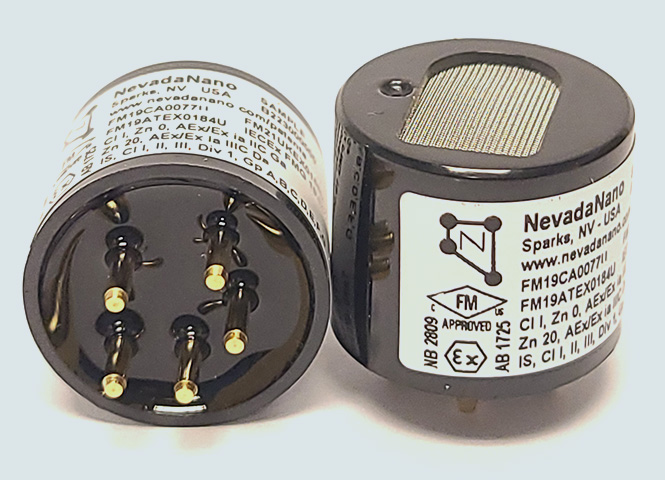Sensing Needs in the Heating, Ventilation, Air-Conditioning, and Refrigeration Industry
The HVAC-R industry is sprinting to keep pace with the rapidly changing regulations which require a transition to low Global Warming Potential (GWP) refrigerants for Heat Pumps, Air-Conditioners, and Refrigeration. Due to the safety hazards of many of the low GWP refrigerants, NevadaNano is at the center of this transition with high reliability sensors that meet the demanding needs of this industry.
The Importance of Refrigerant Gas Sensors in the HVAC and Refrigeration Industry
Mitigating Climate Change in the Heating, Ventilation, Air-Conditioning, and Refrigeration Industry
In the worldwide effort to mitigate climate change, the Heating, Ventilation, Air-Conditioning, and Refrigeration industry (HVAC-R) is going through momentous changes. The use of HVAC-R to keep our homes warm, electronics cool, indoor air comfortable and food safe is a cornerstone of the world economy, currently representing a $200B per year industry. Unfortunately, many of the refrigerants used until now have high Global Warming Potential (GWP), that is, a high potential to contribute to global warming. Since 2000, HVAC manufacturers have used hydrofluorocarbons (HFCs) extensively, however, their high GWP, often thousands of times higher than CO2, adds to global warming. The Kigali Amendment to the Montreal Protocol, adopted in 2016, aimed to reduce the production and use of HFCs to reduce the impact of refrigerants on the climate. Initiatives in the US and EU, such as the AIM Act and the F-Gas Regulations respectively, have imposed deadlines for the elimination of these gases. This has led to the adoption of Low GWP refrigerants, many of which are flammable and pose safety hazards in the event of a refrigerant leak. Currently the HVAC-R industry is transitioning from non-flammable A1 refrigerants to mildly flammable A2L and highly flammable A3 refrigerants, which are much better for the environment but require leak detection sensors for safe operation.
NevadaNano’s family of Molecular Property Spectrometer™ (MPS™) Refrigerant Gas Sensors serve these fast-changing needs with precise and dependable detection of a wide variety of refrigerants commonly used in HVAC applications
Safety First
Refrigerant gas sensors detect and alert for potential leaks, preventing accidents and preserving the health of HVAC-R workers and building occupants.


Efficient Operations
The MPS™ sensor provides real-time monitoring of refrigerant levels, leading to more efficient HVAC-R performance and reduced energy bills.
Environmental Responsibility
The MPS™ sensor helps HVAC-R systems adhere to environmental regulations and avoid the costly penalties that come with non-compliance.

Challenges Faced In the HVAC and Refrigeration Industry

Operational Maintenance
Frequent Calibration: The need for regular recalibration of HVAC and refrigeration equipment can pose a significant operational challenge. Calibration ensures accurate performance, but it can be time-consuming and may lead to downtime.
Cost of Ownership: The overall cost of owning and maintaining HVAC and refrigeration systems can be substantial. This includes not only equipment purchase but also ongoing maintenance, energy consumption, and compliance with environmental regulations, which can strain budgets and resources.
False Alarms
Cross Interference and Poisoning: False alarms can result from cross-interference or poisoning caused by various external sources, such as cleaning fluids or aerosols. These substances can disrupt the proper functioning of sensors and detectors, leading to inaccurate readings and unnecessary alarms. Managing and mitigating these interferences can be a significant challenge for the industry.
Environmental performance
Stability Across Wide Environmental Range: Maintaining stable and efficient performance across a broad environmental range, which includes temperature and relative humidity variations from low to high extremes, is a significant challenge in the HVAC and refrigeration industry. HVAC systems must consistently provide comfort and meet performance standards regardless of environmental conditions, which can be demanding and complex to achieve.
Lifetime
Traditional Sensor Technologies: Many traditional sensor technologies in HVAC and refrigeration systems have relatively short lifespans, typically ranging from 3 to 7 years, depending on the specific sensor technology. These shorter lifespans can lead to frequent replacements, resulting in increased maintenance costs and potential disruptions to operations.
Comparison with MPS™: In contrast, modern sensors like the MPS™ (Molecular Property Spectrometer™) offer significantly longer lifetimes, up to 15 years or more. This extended lifespan can result in lower replacement costs and reduced overall cost of ownership over the long term, making it an attractive option for businesses seeking to optimize their HVAC and refrigeration systems.

HVAC Industry Requirements The Benefits of the MPS Refrigerant Gas Sensors
Increased Safety and Efficiency
The MPS™ sensor’s real-time refrigerant monitoring offers a multitude of advantages. It enhances safety protocols by promptly detecting and alerting to potential refrigerant leaks, minimizing risks to both personnel and the environment. Additionally, this vigilant monitoring optimizes energy consumption, leading to more efficient HVAC-R systems and reduced carbon emissions. In essence, the MPS™ sensor not only safeguards against potential hazards but also contributes to sustainable and eco-friendly hvac operations.
Compliance with Environmental Regulations
The MPS™ sensor plays a crucial role in helping HVAC-R systems align with environmental regulations and guidelines. By offering real-time refrigerant leak monitoring and early leak detection, it aids in minimizing the environmental impact of HVAC-R operations. This proactive approach not only enhances environmental responsibility but also ensures that systems remain compliant with regulatory requirements. The MPS™ sensor is a valuable tool for businesses seeking to uphold eco-friendly practices and fulfill their environmental obligations.
Cost Savings
The MPS™ sensor delivers substantial cost savings by addressing various cost-intensive factors within HVAC-R and refrigeration and cooling systems. Its real-time monitoring and early leak detection capabilities help minimize:
Refrigerant Loss: By promptly identifying and addressing leaks, the MPS™ sensor reduces the need for frequent refrigerant refills, saving on the recurring cost of refrigerant materials.
Regulatory Penalties: Compliance with environmental regulations is crucial. The MPS™ sensor helps avoid potential fines and penalties associated with refrigerant emissions that exceed allowable limits.
Downtime: Swift refrigerant leak detection means faster response and repair, reducing the downtime of HVAC and refrigeration systems and minimizing disruptions to operations.
Maintenance Costs: Its long lifespan reduces the frequency of sensor replacements and maintenance, saving on operational expenses.
Easy Installation and Maintenance
The MPS™ sensor offers a hassle-free experience for users due to its straightforward installation process and minimal maintenance requirements. Its user-friendly design and simplicity make it an ideal choice for integration into any refrigerant leak detection system. With quick and easy installation, businesses can swiftly enhance their refrigerant leak detector and monitoring capabilities without significant downtime or complexity. Additionally, the low-maintenance nature of the MPS™ sensor ensures that it continues to operate efficiently with minimal upkeep, reducing the demands on maintenance personnel and contributing to the overall ease of HVAC-R system management.
Applications of the MPS™ Refrigerant Gas Sensor
The MPS™ sensor has a wide range of applications in both commercial and residential HVAC systems, including commercial refrigeration units, industrial HVAC facilities, and residential cooling systems
Commercial Refrigeration Units
- Bars and restaurants
- Grocery stores and supermarkets
- Pharmaceutical companies
- Blood banks and laboratories
Industrial HVAC Facilities
- Hospitals and healthcare facilities
- Manufacturing plants
- Office buildings and municipal facilities
- Universities and research centers
Residential Cooling Systems
- Single-family homes
- Multi-unit apartment buildings
- Mobile homes
- Senior living communities
Data Centers
- Hospitals and healthcare facilities
- Manufacturing plants
- Office buildings and municipal facilities
- Universities and research centers
